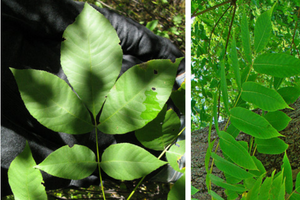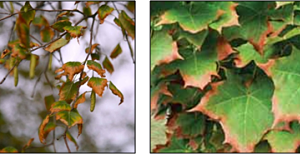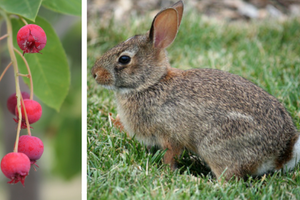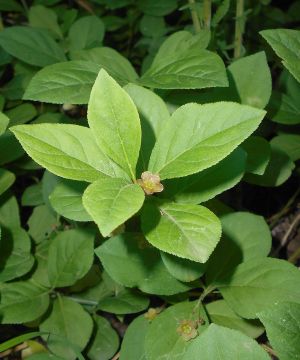Q: I often prune my own trees, but with large branches I'm never sure about the correct pruning cut to prevent tearing. I know that arborists cut a notch above, and one below. What is the correct order, spacing and depth of each cut?
A: Let’s start at the beginning with pruning. Generally, structural pruning is done three to five years after planting. Never remove more than 25% of the leaf area of a tree in any one year as this causes too much stress to the tree.
Pruning large trees can be dangerous. If you are not able to safely get above the branch (you should never be reaching above your head to prune, as the risk of injury is very high), or if the pruning requires power equipment, you should hire a qualified tree care company. Experienced arborists can determine the type of pruning necessary to improve the health, appearance, and safety of your trees. A qualified company can also provide the services of a trained crew with the required safety equipment and liability insurance. See our factsheet Tips for Selecting a Qualified Tree Care Company.

A LEAF arborist demonstrates best pruning practices.
Most routine pruning to remove weak, diseased, or dead limbs can be accomplished at any time during the year with little effect on the tree. As a rule, growth and wound closure are maximized if pruning takes place in early spring, well before leaves emerge. However, be sure to watch out for nesting animals! If you do see birds or small animals like squirrels, don’t move them, just monitor the situation and prune once the babies are gone.
The notches are part of a technique arborists use to reduce the possibility of tearing the bark on the trunk of the tree. The first cut is just an undercut notch and should be made about 12 to 18 inches from the limb’s point of attachment. The second cut is made from the top, a few inches out from the first undercut. This second cut should be made all the way through until the limb falls. This removes the weight of the limb, leaving a 12- to 18-inch stub. Now the stub can be removed with no risk of tearing the bark on the trunk since the weight of the branch is gone. The third and final cut is made just outside the branch collar (raised tissue that separates the branch from the trunk). It is very important not to cut into the branch collar, as this area contains the special cells that allow the tree to compartmentalize the wound (See ISA Trees are Good for more).

Pruning cuts should be made just outside the branch collar. The branch collar contains special tissue and should not be damaged or removed.
Q: I have a hard time distinguishing between trees with compound leaves - particularly hickories vs. walnuts. Could you provide any tips?
A: Great question! These two trees both have alternate leaf arrangement, and the leaflet shapes are similar. Hickories have a leaf with nine or fewer leaflets, while walnuts have nine to 21 leaflets. However, the main distinguishing feature is that the hickory tree has a disproportionately larger terminal leaflet (the leaflet at the end of the leaf stem).

Note the disproportionally large terminal leaflet on the hickory leaf. The walnut leaf does look similar but has a proportionate terminal leaflet, and often more leaflets per stem.
Q: Why is my birch tree shedding leaves in July?
A: Shedding leaves in summer is commonly a result of a drought. Trees sometimes set more leaves in the spring than they can support during the summer. During a hot, dry summer, drought stress may cause the tree to lose leaves that it cannot support with the available soil moisture. The fast, intense bursts of rain we’ve had this summer are not ideal for trees, as there is such a high volume of water that most of it becomes runoff, and cannot be absorbed into the soil quickly enough to help your tree.
If falling leaves are evenly distributed throughout the tree and result in a general thinning of the leaves, the problem may not be too serious and the tree can likely recover. If the leaf drop is happening in one particular area of the tree, and if the buds die and the twigs become brittle, the issue may be more serious and you should seek advice from an arborist.
Overwatering can also sometimes cause leaf drop. If the leaves are drooping before they drop, rather than curling up and becoming crispy, then too much water may be your problem. This can happen in soils with high clay content, where drainage is poor and tree roots are struggling for oxygen.
The best way to judge whether or not your tree needs water is to stick your finger deep into the soil underneath the mulch at the base of your tree before watering. If it is cool and moist, your tree should be good for a few days, but if it is hot and dry, your tree is in need of a drink! On average, younger trees will benefit from approximately three watering cans full, twice per week.
In addition to regular watering, it is wise to add a one-inch layer of organic compost underneath a two-inch layer of natural mulch. Be sure to place it in a doughnut shape around the trunk, preventing the compost or mulch from touching the trunk, as this can promote rot. The compost will improve soil health-and the mulch is great for holding in moisture around the base of the tree and slowly releasing it into the ground.

Often described as the leaves drying up or curling, drought stress can exhibit some of the same symptoms as a tree that is getting too much water. Perform a manual check of the soil before changing your watering behaviour to see which issue your tree is suffering from.
If the fallen leaves look blotchy, blackened or eaten, then your tree may have a pest or disease. We have links on this page for common diseases and pests and how to treat them.
Q: How does one get rid of mould on tree leaves?
A: It could be that your tree is experiencing powdery mildew. Powdery mildew is just as its name suggests: a white, powdery substance that is present on tree leaves and cannot be scraped off. There are a variety of different mildew fungi and each one is host-specific, so the mildew you see on one tree won’t be the same as you see on another.

Powdery mildew is often described just as its name suggests: a white, powdery substance present on tree leaves that cannot be scraped off. Homeowners may have a small infection or a yard-wide infection.
Lucky for us, powdery mildew generally does not impact the health of a tree and there are a few easy steps you can take to avoid getting it back next year. First of all, powdery mildew loves to develop its spores in shady spots with high humidity levels (usually around 90%) and low air flow, so you can increase sunlight levels and air flow by pruning/thinning out nearby trees and/or shrubs. Second, because aerial water increases humidity, avoid watering your tree with a sprinkler since overhead watering can leave foliage wet and prone to fungal diseases. Instead, use a watering can or hose. On average, young trees should be watered twice per week using approximately 6 gallons of water each time. That is the equivalent of using 3 full watering cans twice per week or using a hose with no nozzle on a very, very slow trickle for approximately 15 minutes twice per week. Your tree will also benefit from a layer of compost and mulch (see instructions above).
Third, the most effective way to avoid reinfection next year is to not let the infected leaves lie. Rake up all of the leaves from the affected tree as soon as they come down and dispose of them through a municipal compost program. Avoid putting them in your backyard composter will it likely not reach the temperatures needed to kill off the spores.

This young tree has a lovely mulch doughnut layer, lying above a compost layer. This provides a nutrient supply and additional water absorption for the tree to recover.
Ultimately, powdery mildew is more unsightly than it is harmful and following these easy steps should help reduce it next year!
Q: I have a serviceberry bush that is being eaten by rabbits. What is the best way to protect the bush until it grows a bit bigger?
A: A chicken wire fence is your best bet for protecting your serviceberry shrub until it gets large enough to withstand any damage. Serious damage occurs when the plant is small and the critter is chewing on the bark. Just three wooden stakes placed about 6 to 12 inches out from the shrub, with chicken wire attached will deter hungry wildlife looking to enjoy the bark of your serviceberry. This is a temporary, non-chemical solution and the materials are readily available at most garden centres.

It’s hard for any species to resist these scrumptious serviceberries.
Q: What ground cover is native? Each year I replace grass on my property with something native. I want to keep going!
A: We’re so glad to hear this! Not only are you maintaining plant diversity, but you’re supporting animal diversity through habitat and food! Hopefully, you’ll get squirrels, bunnies, pollinators and more who will visit your yard-en! Here are some native groundcover options:

The running strawberry (Euonymus obovatus) grows best in rich, moist soil and full shade.

Wild ginger (Asarum condense) grows in rich, moist soil with full shade, much like it would have in its natural forested environment.

Creeping floamflower (Tiarella cordifolia) prefers rich, moist soil, and does best in full to partial shade.
The Government of Ontario has a great resource called Grow Me Instead. Check it out for native species alternatives to common invasive plants.
LEAF offers a subsidized Backyard Tree Planting Program for private property. The program is supported by The Town of Newmarket, The Regional Municipality of York, City of Toronto, Toronto Hydro, Oakvillegreen, Town of Ajax, and Ontario Power Generation. For details on how you can participate, visit www.yourleaf.org
